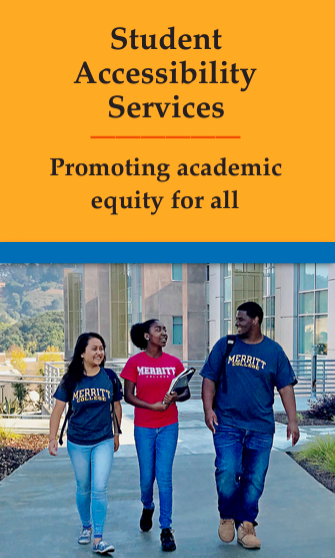Learning disabilities affect the manner in which individuals with average or above average intelligence receive, process, retain and/or express information. A learning disability is NOT to be confused with generalized low ability. Learning disabilities are invisible but may affect a student’s performance in reading, writing, spoken language, mathematics, orientation in space and time and/or organization. The areas of difficulty will vary from one student to another.
Definition:
According to the Title 5 regulations which govern the California Community Colleges, the definition of a learning disability is as follows:
Learning disability in California Community College adults is a persistent condition of presumed neurological dysfunction which may also exist with other disabling conditions. This dysfunction continues despite instruction in standard classroom situations.
Learning disabled adults, a heterogeneous group, have these common attributes:
- average to above average intellectual ability;
- severe processing deficit(s)
- severe aptitude-achievement discrepancy(ies)
Characteristics:
Students with learning disabilities might exhibit one or more of the following characteristics:
Reading
- Confusion of similar words, difficulty using phonics, problems reading multi-syllabic words
- Difficulty finding important points or main ideas
- Slow reading rate and/or difficulty adjusting speed to the nature of the reading task
- Difficulty with comprehension and retention of material that is read, but not with materials presented orally
Writing
- Difficulty with sentence structure, poor grammar, omitted words
- Frequent spelling errors, inconsistent spelling, letter reversals
- Difficulty copying from chalkboard
- Poorly formed handwriting –prints instead of using script; writes with an inconsistent slant; has difficulty with certain letters; spaces words unevenly
- Compositions lacking organization and development of ideas
Listening
- Difficulty paying attention when spoken to
- Difficulty listening to a lecture and taking notes at the same time
- Easily distracted by background noise or visual stimulation
- Might appear to be hurried in one-to-one meetings
- Inconsistent concentration
Oral Language
- Difficulty expressing ideas orally which the student seems to understand
- Difficulty describing events or stories in proper sequence
- Difficulty with grammar
- Using a similar sounding word in place of the appropriate one
Math
- Difficulty memorizing basic facts
- Confusion or reversal of numbers, number sequences or symbols
- Difficulty copying problems, aligning columns
- Difficulty reading or comprehending word problems
Study Skills
- Problems with reasoning and abstract concepts
- Exhibits an inability to stick to simple schedules
- Repeatedly forgets things, loses or leaves possessions, and generally seems “personally disorganized”
- Difficulty following directions
- Poor organization and time management
Social Skills
- Difficulty “reading” facial expressions, body language
- Problems interpreting subtle messages, such as sarcasm or humor
- Seems disorganized in space –confuses up and down, right and left; gets lost in a building, is disoriented when familiar environment is rearranged
- Seems disoriented in time–is often late to class, unusually early for appointments or unable to finish assignments in the standard time period
- Displays excessive anxiety, anger, or depression because of the inability to cope with school or social situations
Suggestions:
Detailed Syllabus:
provide a detailed syllabus that includes course objectives, weekly topics classroom activities, required reading and writing assignments, and dates of tests, quizzes, and vacations. Leave a blank space for notes after the outline for each week’s work.
Rules Clarification:
Clarify rules in advance, how students will be graded, whether makeup tests or rewrites of papers are allowed, what the conditions are for withdrawing from a course or getting an incomplete. Include in the syllabus.
Reviews and Previews:
It is extremely helpful if the instructor briefly reviews the major points of the previous lecture or class and highlights main points to be covered that day. Try to present reviews and previews both visually and orally.
Study Aids:
Use study aids such as study questions for exams or pretests with immediate feedback before the final exam.
Multi-sensory Teaching:
Students with learning disabilities learn more readily if material is presented in as many modalities as possible (seeing, speaking, and doing.)
Visualization:
Help the student visualize the material: Visual aids can include films, computer graphics, and illustrations of written text.
Color:
Use color. For instance, in teaching respiration technology, everything related to the body’s respiratory system might be highlighted in green and the digestive system in orange. In complex mathematical sequences, use color to follow transformations and to highlight relationships.
Tactility:
Provide opportunities for touching and handling materials that relate to ideas. Cutting and pasting parts of compositions to achieve logical plotting of thoughts is one possibility.
Announcements:
Whenever possible, announcements should be in oral and written form. This is especially important for changes in assignments or exams.
Distinct Speech:
Speaking at an even speed, emphasizing important points with pauses, gestures, and other body language, helps students follow classroom presentations. Avoid lecturing while facing the chalkboard.
Eye Contact:
This is important in maintaining attention and encouraging participation.
Demonstration and Role Play: These activities can make ideas come alive and are particularly helpful to the student who has to move around in order to learn.
Learning Styles:
Administer a learning style inventory to the entire class.
Other Tips:
- Emphasize new or technical vocabulary.
- Allow time for students to work in small groups to practice, to solve problems, and to review work.
- Break down teaching into small units. Build up to longer units.
Short daily reading assignments will help the student with learning disabilities learn how to budget and organize study time. - Teach students memory tricks and acronyms as study aids.
- Encourage students with learning disabilities to sit in front of the classroom.
- Give feedback. Errors need to be corrected as quickly as possible.
- Assist the student in teaming up with a classmate to obtain copies of notes.
- Read aloud material on the board or on transparencies.
- Remind students often of your availability during office hours for 1-1 clarification of lectures, readings, and assignments.
- Periodically offer tips and encourage class discussion of ways for improving studying– such as organizational ideas, outlining techniques, summarizing strategies, etc.
- Permit use of a calculator when mathematical disability is severe.
- Permit the use of a dictionary or spellchecker for essay exams.
- In exam questions, avoid unnecessarily intricate sentence structure, double negative and questions embedded within questions.
- Give less weight to spelling when the disability is severe.
- Encourage students to use a word processor with a “spelling check” capability.
- Encourage students to dictate best ideas into a tape recorder before writing a report.
- Use yellow chalk (as opposed to white or other colored chalks) on chalkboards, to help students who have visual impairments.
Possible Accommodations:
- Academic support
- Alternative testing (extended time, reader, scribe, distraction reduced setting, and/or computer)
- DSP courses (Study Skills; Computer Access Lab)
- Note-taking assistance
- Textbooks in audio format
To arrange for an appointment with a DSP Counselor:
Download the Disability Verification Form and the Learning Disabilities Referral Form
• Fill them out.
• Call 510-436-2429 or drop by R-109 to make an appointment.
• Bring completed forms to your appointment.
• Bring supporting documentation on learning disabilities to your appointment.
Downloads:





